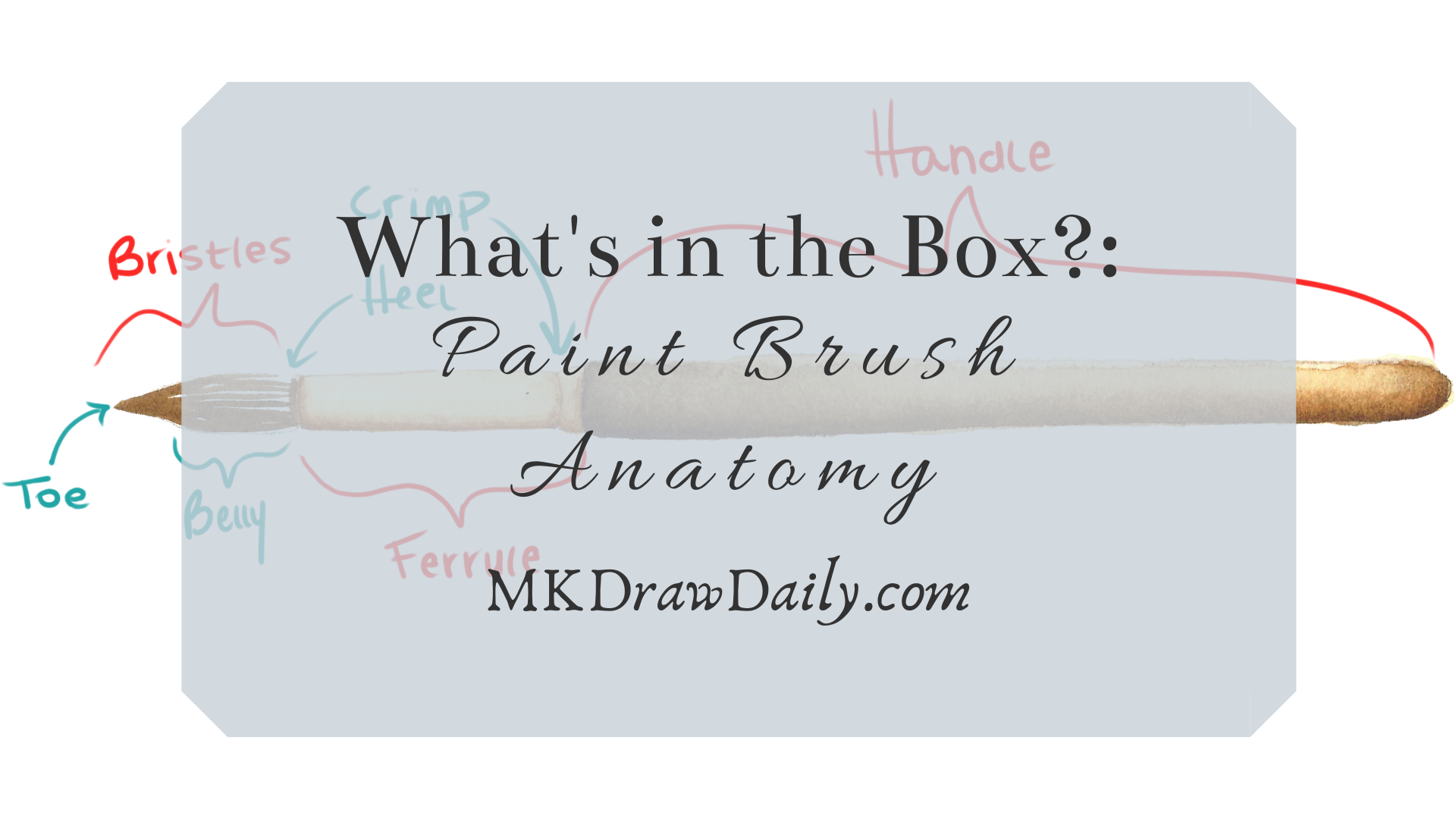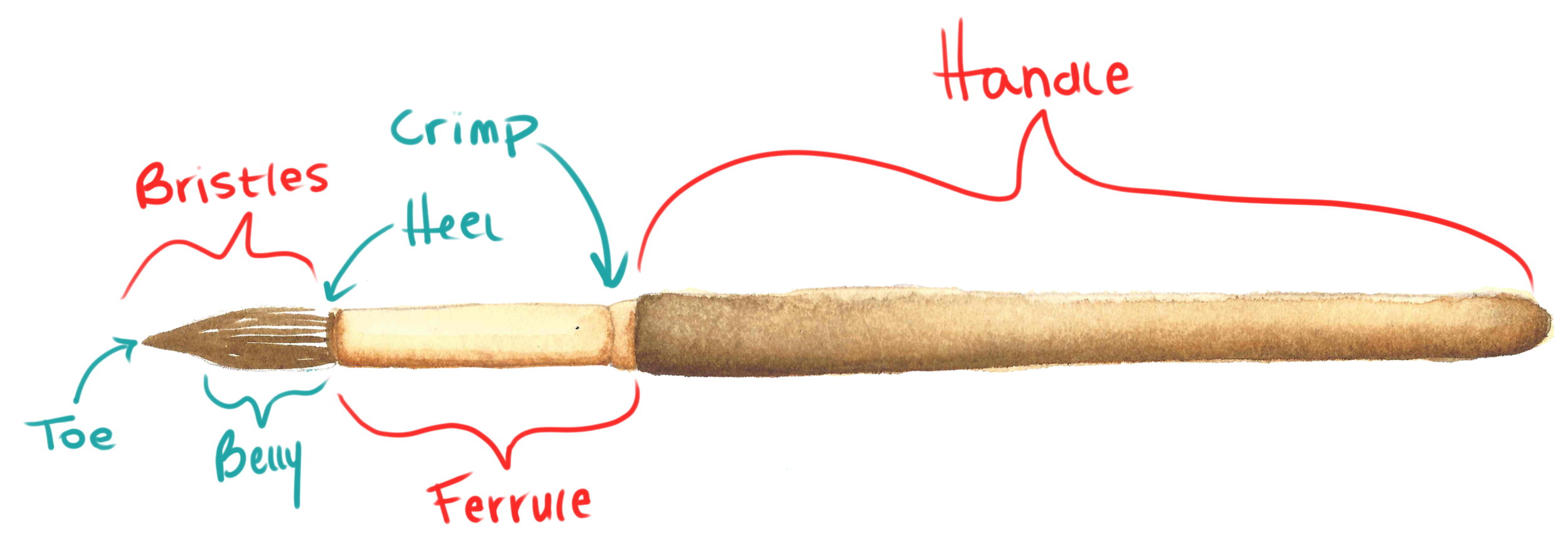What’s in the Box!? Paint Brush Anatomy
AN EASY GUIDE TO ESSENTIAL ART TOOLS
Paint Brush Anatomy | Paint Brush Types | Popular Brands | Paint Brush Tips
Welcome back to my official blog guide, “What’s in the Box!?”
And today we are going to approach the topic of watercolor paint brushes.
Watercolor paint brushes are a unique breed compared to paint brushes used for other mediums, ones that you might be more familiar with. For watercolor, they need to hold more than paint, they need to have a large belly to hold the water that the artist uses to dilute, move, and transfer paint onto the canvas. These paint brushes sport long and absorbent bristles that are known for their ability to hold a precise point which have the ability to retain their shape over time providing the artist with a precision tool designed precisely for this medium.
With all of that in mind, we are going to be looking at, not only the anatomy of the paint brush, but also the materials that watercolor paint brushes are commonly made of.
THE PAINT BRUSH
PAINT BRUSH ANATOMY
Paint brushes are made of three individual pieces, the bristles - which are what carries the water and paint, the handle, and the ferrule - which is what connects the bristles to the handle. These three components can be made from a variety of different materials, depending on what your needs are, how much money you are willing to spend, and what your personal beliefs are; aka if you are vegan. I’ll just say this up front for anyone who might not know this, but most paint brushes are made with animal products or byproducts on some level or another, but there are vegan choices available, just keep reading, or jump to Popular Brands.
OTHER NEED-TO-KNOW AREAS
As you might have gathered from the image, there are a few areas other than just the bristles, handle, and ferrule that would be useful to know. As far as the bristle area we have another 3 vocabulary words that may prove useful while learning and exploring the watercolor art world.
The Toe
The very tip of the brush or the area that is going to be doing most of the painting and most often making contact with your canvas is called the toe. This is also the area that is expected to hold a sharp point and needs the most care throughout the whole painting and cleaning process.
The Belly
The belly of a watercolor paint brush is arguably one of the more important features designed especially for the watercolor medium. Many types of mediums don’t rely on the paint brush being able to absorb paint rather they are designed to either scoop up or drag paint across the canvas. Alternatively watercolor paint brushes do require not only the ability to hold large amounts of water and similarly drag the paint across the page, but these bellies are also designed to distribute its contents evenly across large areas of paper without expelling its load at either at the start or end of the brushstroke. At least this is what a belly is intended to do, inexpensive brushes may not hold to such a standard.
The Heel
The heel of a paintbrush is the area where the bristles and ferrule come in contact and is an important area of your paintbrush to pay attention to. You will want to avoid getting paint in this area of the paint brush, and if you do, it requires deep cleansing after use. The problem with gunk and paint getting stuck this far down can cause brushes to prematurely puff or fray making it hard for the paint brush to come to a sharp point. Before you cast a brush aside try giving this area of the brush a good washing and then see if it improves the brushes toe.
The Crimp
The last vocabulary word we will go over is the crimp, or the area of the ferrule that has been tightly restrained to the handle. This is so that the bristles and ferrule remain tightly secured to the handle helping to avoid a handles premature departure helping your paint brush live a longer, healthier life.
THE BRISTLES
So, there are basically three types of materials that the bristles of a paint brush can be made from. Those that are fully synthetic are made from man-made-materials such as nylon and polyester, then semi-synthetic are made from a blend of both synthetic and “natural” hair referring to animal hair, and fully “natural” brushes which are made exclusively from animal hair. The most popular being squirrel, goat, ox, and the top spot being reserved for sable. Some of the more common watercolor paint brushes however, are currently made from squirrel, or a mix of synthetic and squirrel, or synthetic-squirrel.
But sable are top quality, best in the business with prices sky rocketing into the hundreds of dollars depending on how big the brush is (and honestly they don’t actually need to be that big to come with a bigger price tag.) For example, a, what is known as a Kolinsky Sable (top of the top) by Princeton (top of the top and a valued manufacturer that I’ll talk more about in a moment), sell their size 10 round brush, which is about 8mm wide and is both a medium sized brush and a very common sized brush for a watercolorist to own, and they sell theirs for anywhere between $95 to about $150, depending where you pick one up. In contrast, the same sized paint brush, made by the same company but sporting a synthetic sable brush sells for between $10 - $19.
THE HANDLE
The handles for watercolor paint brushes are usually made from wood or plastic. Not quite as controversial, but the look and material can also depend on their price point. More inexpensive handles tend to be plastic or unfinished wood, but as you go up in price range you’ll usually see wooden handles are either stained or lacquered, some with curves meant to be more ergonomically designed so they bulge in the area intended to be handled.
You’ll find that there are few different designs, and when talking about watercolor in particular you are going to hear that many brushes are labeled as having ‘short handles’ and this has to do with the intimacy between you and your painting. Other mediums like oils and acrylics are better known for having ‘long handled’ paint brushes so that the artist can step away from their canvas by inches or even feet to have a better feel for the overall look of their work without getting too bogged down with the minutia. Watercolor on the other hand is intended to be more intimate and requires more of a personal touch and thus long handles would just be unnecessary and even awkward in the hands of a watercolor artist.
THE FERRULE
Most ferrules are made from metal and, on any paint brush worth its salt, is made from brass or copper because they are corrosion resistant. Paint brushes are exposed to a lot of water within their lifetime and you don’t want your paint brushes rusting out on you. More inexpensive choices might sport aluminum or tin, only because it is more inexpensive, but aren’t as resilient.
There are exceptions such as the quill brush, which I will expand on in just a moment, but there are other variations depending on where you are in the world. In East Asia they have traditional round paintbrushes made for ink paintings and calligraphy that sport variations on the ferrule which aren’t too different from what is more commonly used today, while others have a small ferrule, like the Princeton Bamboo paint brush, or no apparent ferrule at all as seen on some traditional Eastern Asia calligraphy brushes.
FIN
I hope that this has helped dispel your curiosities regarding the anatomy of the watercolor brush. The next topic I will be breaching will include the various watercolor paintbrushes that are out there and available for purchase. I’ll discuss their uses and even suggest what brushes you might want to add to your collection, especially if you are just starting out and aren’t sure what a good go-to brush would be. Stick around for that, and more!
That’s it for today, thanks for reading.
I’m MK and this is Draw Daily!



